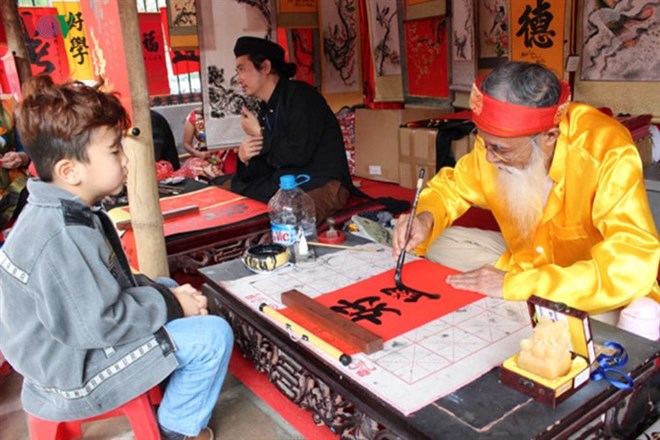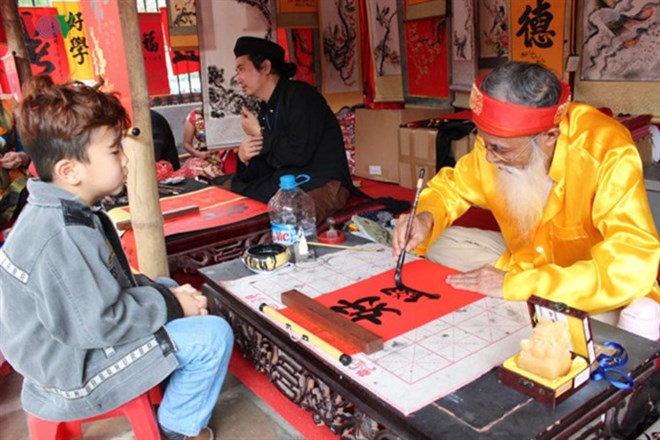
The annual Spring Calligraphy Festival will be held at the Literature Lake, a part of the Van Mieu (Temple of Literature) on February 9-25.

Artists
display calligraphic skill (Photo: vov.vn)
For years, Hanoians have visited the Temple of Literature to have meaningful
words written in calligraphy, aiming to attract good fortune in the New Year.
The calligraphic works are then used to decorate their house during the New
Year celebration.
Le Xuan Kieu, Director of the the Van Mieu – Quoc Tu Giam Cultural and
Scientific Centre, said the festival aims to promote traditional culture and
preserve the calligraphic art.
On red or yellow do (poonah) paper, they write words in traditional and
Vietnamese scripts intended to bring good health, luck and prosperity for those
in attendance.
This year, 55 calligraphers who are members of calligraphic clubs and selected
from a writing competition will perform the writing.
The artists, wearing ao dai (long robes), will sit in bamboo tents following
the traditions of the past.
One highlight of the festival is an exhibition of 35 calligraphic works written
in Vietnamese and Han-Nom scripts. The writings follow the theme of talent and
righteousness to honour the tradition of learning.
In the framework of the festival, an exhibition of traditional crafts such as
pottery, paper making, embroidery, wood carving and bronze casting will be
held.
Visitors can also learn about poonah paper and how it’s made. Beside
calligraphy, poonah paper is also used to print folk paintings and colourful
Dong Ho, Kim Hoang and Hang Trong paintings.
The festival will also feature traditional New Year food, such as chung (glutinous
rice) cakes and spring rolls, as well as art performances like cheo
(traditional opera), hat van (spiritual singing in Mother Goddesses worship),
quan ho (love duets), hat xoan (spring singing from Phu Tho province) and ca
tru (ceremonial singing).
Folk games will be available for children and visitors can also release flower
lanterns to the Literature Lake to wish for good things.
The events are taking place from January 21 to February 11 at Van (Literature)
Lake, Quoc Tu Giam street, Hanoi.
Source: VNA
With an increasingly vibrant and widespread emulation movement aimed at building cultured residential areas and cultured families, Yen Thuy District has been making steady progress toward improving both the material and spiritual well-being of its people, while fostering a civilized, prosperous, beautiful, and progressive community.
Once lacking recreational spaces and community facilities, Residential Group 2 in Quynh Lam Ward (Hoa Binh City) has recently received attention for the construction of a new, spacious, and fully equipped cultural house. The project followed the model of state support combined with public contributions in both labor and funding.
The "All people unite to build cultural life" movement, which has been effectively integrated with Kim Boi district’s socio-economic development goals, is fostering a lively spirit of emulation across local residential areas, hamlets, villages, public agencies, and enterprises. In addition, through the initiative, traditional cultural values are being preserved and promoted, while community solidarity and mutual support in poverty reduction and economic development are being strengthened.
A working delegation of the Hoa Binh provincial People’s Committee led by its Permanent Vice Chairman Nguyen Van Toan on June 11 inspected the progress of a project to build the Mo Muong Cultural Heritage Conservation Space linked to tourism services in Hop Phong commune, Cao Phong district.
Born and growing in the heroic land of Muong Dong, Dinh Thi Kieu Dung, a resident in Bo town of Kim Boi district, in her childhood was nurtured by the sweet lullabies of her grandmother and mother. These melodies deeply imprinted on her soul, becoming an inseparable part of her love for her ethnic group's culture. For over 20 years, this love for her hometown has driven Dung to research, collect, and pass down the cultural values of the Muong people to future generations.
In the final days of May, the Ethnic Art Troupe of Hoa Binh Province organized performances to serve the people in remote, mountainous, and particularly disadvantaged areas within the province. These were not just ordinary artistic shows, but they were the meaningful journeys aimed at spreading cultural values, enhancing the spiritual life of the people and contributing to the preservation of ethnic minority cultural identities.


